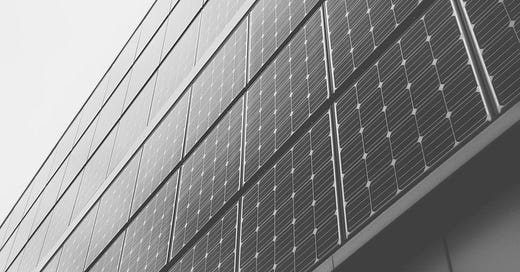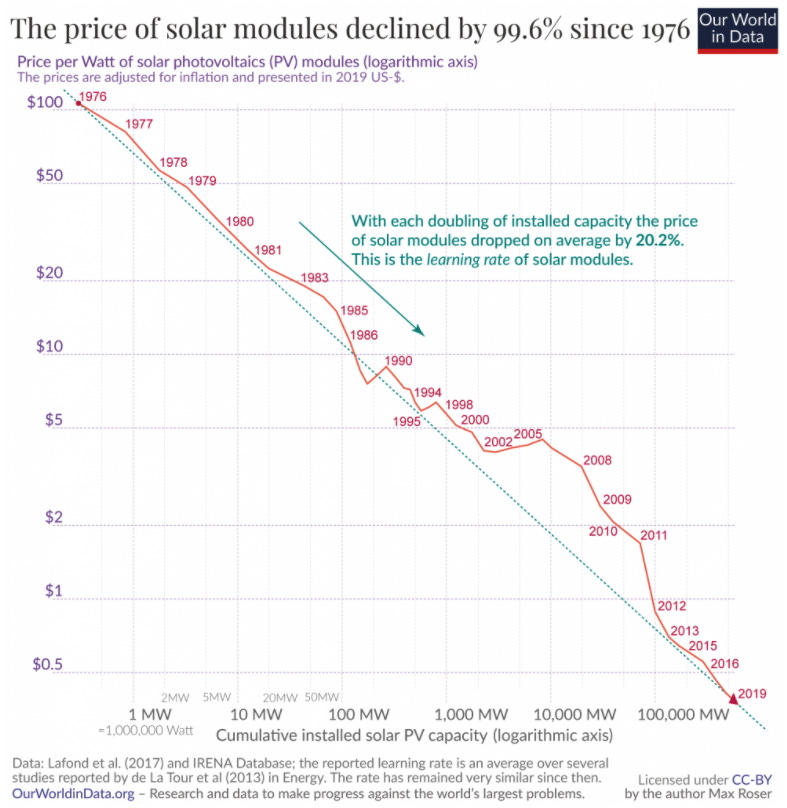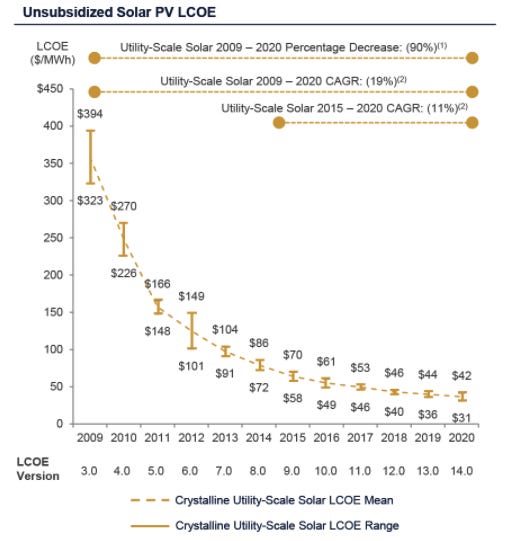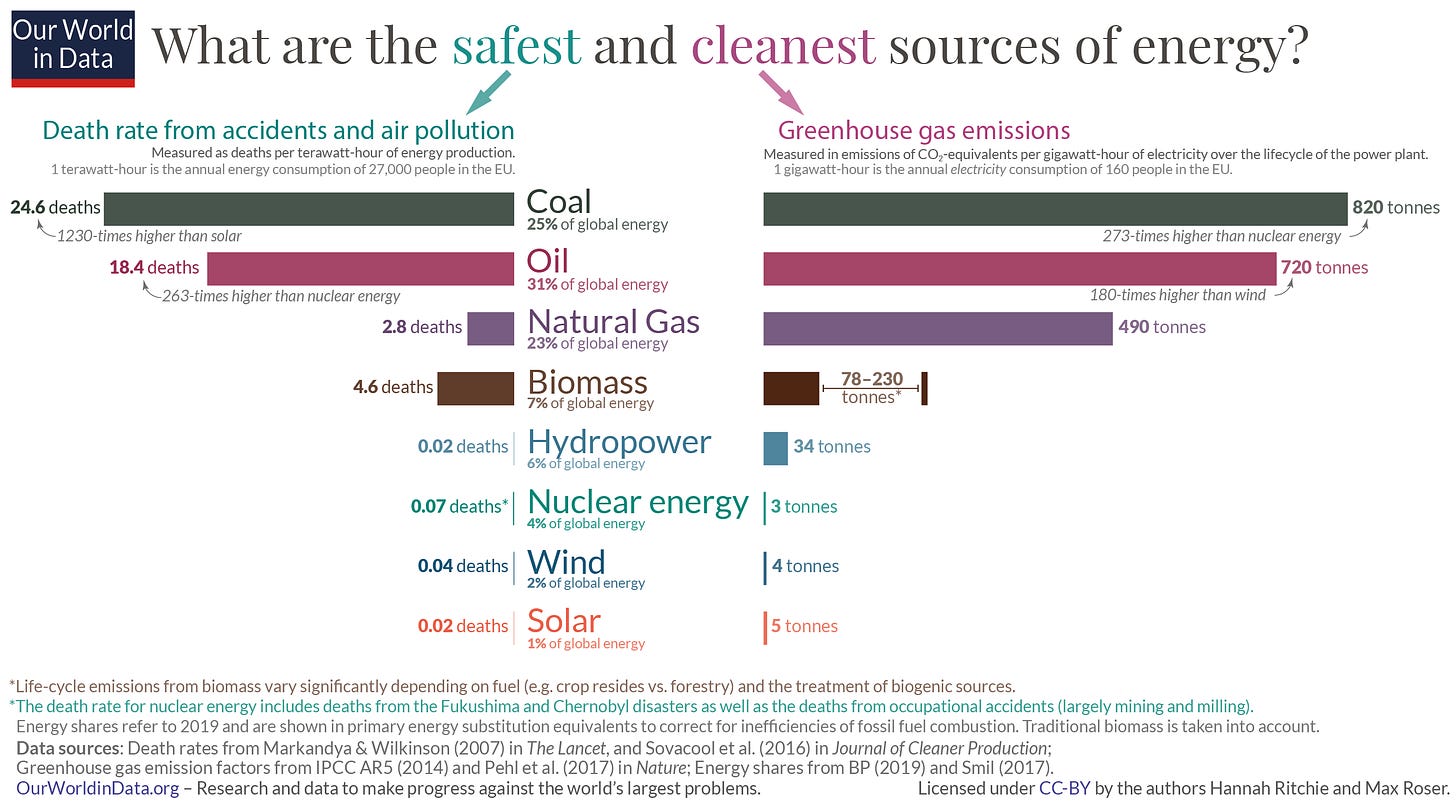“The amount of sunlight that strikes the earth's surface in an hour and a half is enough to handle the entire world's energy consumption for a full year.” - Office of Energy Efficiency & Renewable Energy
The quote above inspired us to write this newsletter on how solar energy works.
There are 2 main types of solar energies: photovoltaics (PV) and concentrating solar-thermal power (CSP).
Photovoltaics
If you remember from your high school or college chemistry class, the photoelectric effect was discovered in 1839 by Heinrich Hertz. This phenomenon describes the absorption of electromagnetic radiation (light), causing electron emission which can be captured to produce electric current. Different frequencies of light produce different voltage outputs.

Concentrating Solar-Thermal Power
CSP converts solar energy into heat/thermal energy by various mirrors, which then produces electricity via turbines or stores electricity via Thermal Energy Storage techniques (TES) like molten salt storage. CSP utilizes the sun’s heat whereas PV uses sunlight. Because CSP requires more moving parts, it’s more fit for larger facilities like power plants as opposed to single family homes.

AC, DC, and Inverters
Nikola Tesla and Thomas Edison advanced Alternating Current (AC) and Direct Current (DC) power, respectively. In their early days, the electric power industry was still deciding which type would become the standard for supplying energy. In the end, AC won because it travels much easier over long distances over the grid.
However, solar panels emit electrons in one direction which creates DC power. Because the grid operates on AC, solar inverters are required to convert DC to AC so that everyone can use it including the power company. Many electronic devices use DC power; the large power adapters for your laptop and phone chargers contain inverters to turn AC into DC power.
In 2017, California mandated Rule 21, which requires everyone to use Smart Inverters which contain additional software to stabilize electricity flows to and from the grid. When the grid experiences a disturbance, it can trip additional inverters causing more disturbances in a feedback loop ultimately resulting in blackouts and brownouts. Smart Inverters help stop these feedback loops which stabilizes the grid as more and more renewable energy sources are added over time.
Energy Storage
While solar panels provide energy for you when the sun is out, what do you do after sunset? The solution is simple: batteries for energy storage. However, the implementation of this solution is difficult due to the current inefficiencies in energy storage. Any unused AC current can be converted back to DC and stored in the battery. During the absence of sunlight or blackouts, these batteries kick in to power your home. If the battery is full while the solar panel is producing energy, this surplus can be sold back to the utility company by exporting the power back to the grid.
Some utility companies also have time-of-use (TOU) rates which charge users more per kilowatt hour during peak consumption times. This means that you can get cheaper rates by using electricity when others aren’t. That’s why batteries offer users the ability to bypass the TOU rates by never using energy supplied by the utility company.
For CSPs, there are not only electrical batteries but also thermal batteries that store heat. These TES units enable the system to continue producing power even after sunset which provides a consistent power source independent of the electrical battery storage. For example, the sun’s heat can produce molten salt which stays hot long enough to power a steam engine for 12 hours of darkness.
Types of Batteries
Batteries are key buffers in an energy efficient system providing stability across the grid to help with blackouts and disturbances. Below, we discuss a few battery technologies used in solar today.
Lithium Ion - these are the safest and most widely used with high energy density. They come in 2 flavors: LFP (Lithium Iron Phosphate) which are stable and performant; NMC (Lithium Nickel Magnesium Cobalt) which have higher energy density but lower thermal stability.
Lead Acid - these batteries are the old technology powering cars today. They have low energy density and shorter life cycles, but they are extremely cheap to produce.
Flow - these use a water-based liquid like Zinc Bromide flows between 2 tanks and can discharge 100% unlike traditional batteries. They are also fire-proof and have almost no lifespan issues.
Solar Companies
Let’s take a look at some companies that play large roles in the solar industry.
Enphase ($ENPH) - the pioneer of microinverters and focused on shipping these components out to North America, Europe, and Australia. They remain the leader in this space to this day.
Sunrun ($RUN) - offers solar service plans for households at little to no upfront cost to simplify people’s transition to solar. They also provide a home battery solution called Brightbox.
First Solar ($FSLR) - finances, engineers, and constructs many of the world’s largest grid-connected PV power plants. They claim to have the strongest balance sheet in the industry.
In addition to individual companies, there are index funds, such as Invesco’s Solar ETF ($TAN), that allow investors to support and gain broad exposure to solar companies.
The following chart from Koyfin displays the price performance of $ENPH, $RUN, $FSLR, and $TAN over the past year:
Why Now?
Compared to prior years, what makes the solar industry particularly fascinating today?
The progression of Swanson’s Law continues to demonstrate the declining cost curves for solar PV. Swanson’s Law states that for every 2x in cumulative shipped volume, the average price of solar photovoltaic modules drops by 20%.
Unsubsidized solar PV’s levelized cost of energy (LCOE) has followed a declining cost curve, which makes adoption of solar PV to be increasingly attractive. Furthermore, as unsubsidized LCOE declines, solar PV can operate as stand-alone profitable enterprises without the need for massive government subsidies. Nonetheless, government subsidies are helpful in incentivizing behavior that continues the volume production, induces cost declines, and promotes sustainability initiatives. The following chart from Lazard demonstrates the declining unsubsidized solar PV’s LCOE over time:
ESG-friendly investments (ESG = environmental, social, and governance) and climate technologies are increasingly in demand by both consumers and several investors. A changing climate impacts everyone, and the advancement of renewable energy further advances sustainability and decarbonization initiatives.
Compared to other sources of energy, solar-produced energy is remarkably cleaner and safer, as displayed by the following chart from Our World in Data:
The LCOE of solar PV and onshore wind electricity is now lower than the LCOE for new coal power plants, making renewables a price-competitive method of generating electricity that is also environmentally-friendly.
Conclusion
Solar remains a growing industry with numerous moving parts. From panels to batteries to inverters and thermal storage, there are a lot of ways to invest in this industry. As PV systems become cheaper and more efficient, adoption will accelerate until fossil fuel usage becomes insignificant. CSP systems provide a promising alternative to PV that enable energy production all day; we believe this method of energy production should not be overlooked. Lastly, various batteries require many different elements produced from mining companies which provides yet another investment opportunity. However, solar is not the only renewable option; we should also think about wind power, hydroelectric power, and nuclear as well.
To close out, we wanted to share this neat tool that helps users estimate their potential solar rooftop savings. Google Maps uses satellite imagery to estimate the amount of sunlight your roof receives multiplied by the square footage you have available for solar panels to determine cost savings over the next 20 years. https://www.google.com/get/sunroof
References:
"How Does Solar Work? | Department of Energy." https://www.energy.gov/eere/solar/how-does-solar-work. Accessed 1 Mar. 2021.
"Sustainability | Free Full-Text | Performance Analysis and ... - MDPI." https://www.mdpi.com/2071-1050/12/1/127. Accessed 1 Mar. 2021.
"Solar Fundamentals: What's the Difference Between AC vs. DC ...." 18 Sep. 2019, https://www.aurorasolar.com/blog/solar-fundamentals-whats-the-difference-between-ac-vs-dc/. Accessed 1 Mar. 2021.
"Smart inverters redefine relationship between DERs and the grid." 12 Mar. 2019, https://www.solarpowerworldonline.com/2019/03/smart-inverters-redefine-relationship-ders-grid/. Accessed 1 Mar. 2021.
"How Solar Energy Storage Works - Aurora Solar." 8 Jan. 2021, https://www.aurorasolar.com/blog/how-solar-energy-storage-works/. Accessed 1 Mar. 2021.
"Why did renewables become so cheap so fast ... - Our World in Data." 1 Dec. 2020, https://ourworldindata.org/cheap-renewables-growth. Accessed 1 Mar. 2021.
"Levelized Cost of Energy and of Storage - Lazard.com." 19 Oct. 2020, https://www.lazard.com/perspective/levelized-cost-of-energy-and-levelized-cost-of-storage-2020/. Accessed 1 Mar. 2021.
This letter is not an offer to sell securities of any investment fund or a solicitation of offers to buy any such securities. An investment in any strategy, including the strategy described herein, involves a high degree of risk. Past performance of these strategies is not necessarily indicative of future results. There is the possibility of loss and all investment involves risk including the loss of principal.
Any projections, forecasts and estimates contained in this document are necessarily speculative in nature and are based upon certain assumptions. In addition, matters they describe are subject to known (and unknown) risks, uncertainties and other unpredictable factors, many of which are beyond Drawing Capital’s control. No representations or warranties are made as to the accuracy of such forward-looking statements. It can be expected that some or all of such forward-looking assumptions will not materialize or will vary significantly from actual results. Drawing Capital has no obligation to update, modify or amend this letter or to otherwise notify a reader thereof in the event that any matter stated herein, or any opinion, projection, forecast or estimate set forth herein, changes or subsequently becomes inaccurate.
This letter may not be reproduced in whole or in part without the express consent of Drawing Capital Group LLC (“Drawing Capital”). The information in this letter was prepared by Drawing Capital and is believed by the Drawing Capital to be reliable and has been obtained from sources believed to be reliable. Drawing Capital makes no representation as to the accuracy or completeness of such information. Opinions, estimates and projections in this letter constitute the current judgment of Drawing Capital and are subject to change without notice.












